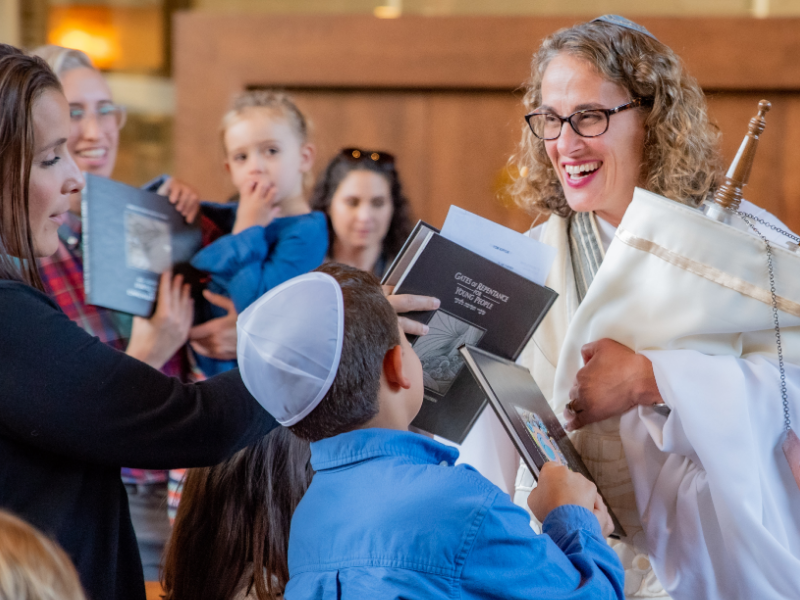
Every now and then, we want to say to the ancient sages, “We owe you one.” This week, when we read the double portion, Vayak’heil/P’kudei, feels like one of those times.
The Hebrew calendar allows festivals and their special Torah readings to fall on Shabbat; adds a leap month at predictable, but irregular intervals; and sometimes requires that we double up Torah readings on a single Shabbat. How the particular double portions were determined is unclear, and occasionally seems unlikely. Lumping together Acharei Mot and K’doshim, for example, seems patently unfair. Each verse of the Holiness Code in K’doshim is ripe for deep reflection unto itself, and Acharei Mot is full of rich drama, as well. Yet this week’s double portion feels like a blessing.
Parshiyot Vayak’heil and P’kudei each cover the many details of the building of the Tabernacle — and not for the first time either. The first blueprint is found in Parashat T’rumah, when Moses receives the instructions for how to build the Tabernacle. There God provides the dimensions, the materials, the furnishings for each element of the Tabernacle; each in excruciating detail. Now, in Vayak’heil, construction finally begins. Though the order of the Tabernacle’s construction does not precisely follow the first set of instructions, all of the details are there — the dimensions, the materials, the furnishings — a second time. But wait, there’s more! In P’kudei, there’s still another itemization of every component used to build the Tabernacle with the same precision of detail.
Imagine coming to services at your synagogue and — for three weeks — hearing a sermon about the wood, nails, plaster, and paint that was used to create the space in which you gather. (I have the great fortune to worship in one of the oldest sanctuaries in America. We are immensely proud of our sacred space and are completing a major restoration of our historic sanctuary as we speak. Yet even our eyes would glaze over if we had to hear about each detail of the work, again and again and again!) So thank you, ancient sages, in whose infinite wisdom Vayak’heil and P’kudei are combined calendrically whenever possible.
Still, each recounting of the details of the construction of the Tabernacle does serve a distinct purpose. The first constitutes the instructions. The second describes the execution of the work. And the third, “drawn up at Moses’ bidding” (Ex. 38:21), provides accountability.
Midrash Tanchuma explains it this way:
[Moses] heard the scoffers of the generation talk behind his back, as is said: “And it came to pass, when Moses went out ... that the people looked after Moses.” And what were they saying? Eyeing him with contempt from behind, one would say to the other: “Look at his beefy neck! Look at his fat thighs! He stuffs himself with what belongs to us and guzzles what is ours.” And the other would reply: “Stupid! A man appointed over the work of the Tabernacle, over talents of silver and talents of gold whose weight and number are too great to measure — what do you expect? That he would not enrich himself?” When Moses heard this talk, he said: “As you live, when the work of the Tabernacle is finished, I will give you an accounting.” When it was finished he said: “These are the accounts of the Tabernacle.” (Midrash Tanhuma, P’kudei 7)
The third account of the details of the construction of the Tabernacle serves as a public audit. And so we learn: Public officials not only have to be honest, they have to appear honest, too.
Using Moses as an example, the teachers of the Talmud held that public officials should always be above suspicion. Their actions, and those of their families, should prove their honesty and integrity. The rabbis point out that, as models of behavior, those who prepared the special fine bread offering for the Temple never allowed their children to enjoy any of it. In this way no one could accuse them of profiting from their office. The same rule applied to members of the house of Avtinas, who were experts in preparing spices for the Temple incense. They never allowed their daughters to wear perfume, even as brides, because they did not want anyone to suspect that they prospered or took advantage of their service to the Temple. (Harvey J. Fields, A Torah Commentary for our Times, Vol. 2, UAHC Press: New York (1991), p. 93, based on Yoma 38)
We are told at the end of Deuteronomy, “Never again did there arise in Israel a prophet like Moses — whom the Eternal singled out, face to face, for the various signs and portents that the Eternal sent him to display in the land of Egypt, against Pharaoh and all his courtiers and his whole country, and for all the great might and awesome power that Moses displayed before all Israel” (Deut. 34:10-12). This and more is certainly true of Moses. If only leaders of all kinds and at all levels would strive to emulate Moses’ high standards of transparency and accountability.
We hold out hope that our public officials, in North America and in Israel, will display the kind of thoughtful and careful leadership modeled by Israel’s faithful shepherd; that they will value the confidence of their citizens and work to hold it in sacred trust; and that, together, we will build societies in which, like the ancient Tabernacle, the Divine Presence can dwell.
Rabbi Stephanie M. Alexander is the senior rabbi at Kahal Kadosh Beth Elohim in Charleston, SC. She is a past-president and founding member of the Charleston Area Justice Ministry, a faith-based social justice organization of 29 diverse congregations.

In the 1970s, cognitive psychologist Ulric Neisser performed a novel experiment. He asked participants to watch a video he had created in which two teams passed, basketballs between them. All the participants had to do was count the number of times the ball was passed. One team had light colored shirts, the other dark. While they had actually been playing separately, Neisser superimposed the videos on top of each other, which made the task of counting the passes more difficult for the participants.
What was so memorable about this study? It’s the fact that only about one in five participants noticed that in the midst of the video, and for a good length of time, a woman walked across the court carrying an open umbrella. When I participated in an updated version of this experiment, I successfully counted the number of times the basketball was passed but failed to notice the person in the gorilla suit, standing center-court for nearly 10 seconds, pounding their chest.
It can be humbling to acknowledge the fact that what we look for — or expect to see — literally determines what we do see. Psychologists call this “bounded awareness.” It impacts medical decisions, business decisions, and ethical choices we make. It also can shape what we see in Torah, as a kind of bounded spirituality, so to speak.
Whether in story form or legal injunction, Torah is usually intensely powerful and decidedly laconic: the universe is created in 34 verses (Gen. 1:1-2:3), the Ten Commandments uttered in 14 verses (Ex. 20:1-14), and the sin of the Golden Calf committed in six (Ex. 32:1-6). As much as we may wrestle with Torah’s teachings, we look for and expect to see its challenge quickly and clearly.
So when we get to Vayak’heil/P’kudei, it can be easy to miss Torah’s spiritual call. As Torah again details, itemizes, and then reiterates every aspect of the construction of the Mishkan (the Tabernacle), we often see only what we expect: a kind of divine IKEA manual, with superficially straightforward instructions that will frustrate, if not thwart most of us.
Yet perhaps the detail is the teaching itself. God can create a universe in 34 verses, yet we need chapters and chapters, and detail upon detail, to build the Mishkan. Why? The answer might be found in the teaching of Rabbi Meïr Leibush ben Yehiel Michel Weisser, the Malbim, on Exodus 25:8. He says we should not understand Mishkan as a physical structure or space, but as a way of being. Torah, he explains, wants us to see that each person should build a Mishkan within the recesses of their heart; they should make their lives a dwelling place for what is eternal — The Eternal (The Torah: A Modern Commentary, rev. ed., p. 557).
To do this, one has to pay attention to the details. Simply put, it is in our day-to-day actions that we define our lives. So the description of the ark, gold-covered outside and in (Ex. 37:2), now becomes a challenge to ensure our inner lives match our outer actions (Babylonian Talmud, Yoma 72b). And the curtains, each “linked together” chiber (Ex. 36:10), lead us to question how and with whom we have intertwined our lives, have made our “friends,” chaveirim. Our portion asks us whether we give of ourselves wholeheartedly and wisely (Ex. 35:5, 35:10), and whether we can recognize the unique gifts that others have to share. One small example: Moses himself was not going to accept the mirrors that the serving women wanted to donate, because he thought they were mere vanity until God enabled him to see how these were the most beloved of donations (Rashi on Ex. 38:8).
If we see our portion asking us to look closely at our lives — plank by plank, tenon by tenon by tenon — we can see the “Torah” hidden within the building plan. And we can begin to understand the amount of space Torah dedicates to this process: 34 verses (seven days) is not enough for us to create our lives. Again and again, over the course of our lives, we must do our inner emotional and spiritual work of ensuring that the pieces of our life fit together to build a truly beautiful Mishkan.
Rabbi Debra Landsberg serves as the rabbi of Temple Emanu-El, Toronto, Canada.
Vayak’heil/P’kudei, Exodus 35:1–40:38
The Torah: A Modern Commentary, pp. 668–687; Revised Edition, pp. 611–636
The Torah: A Women’s Commentary, pp. 521–568
Haftarah for Shabbat HaChodesh, Ezekiel 45:16−25
The Torah: A Modern Commentary, pp. 1,653−1,654; Revised Edition, pp. 1,457−1,458
Explore Jewish Life and Get Inspired
Subscribe for Emails

